#Cinema Era Digital
Text

Em relação ao projeto, eu optei pelo Dreamachine por duas razões. A primeira tem a ver com o fato de eu me interessar muito pela minha forma de pensar e imaginar. Eu costumo meditar mas em vez de esvaziar o cérebro de pensamentos, eu gosto de imaginar histórias. E por vezes consigo mesmo “visualizar” na minha mente. O interessante que seria conseguir criar a visão de todas estas histórias, assim como pretendia Brion Gysin com a sua invenção. A segunda razão tem a ver com a minha procura em entender o outro. Sempre tive a curiosidade de perceber a enorme variedade do talento do ser humano. Apesar da informação fornecida pelo adn, todo o ser humano deveria ser igual e ter as mesmas capacidades. Sendo assim, porque uns são bons a pintar, outros a jogar futebol e outros na matemática? O que faz o homem ter diversos talentos? E na verdade, o gene não é resposta para tudo, porque vemos filhos com talentos diferentes dos pais. Por isso, a Dreamachine parece interessante porque poderia proporcionar uma forma de entendermos as habilidades da humanidade.
0 notes
Text

"Cesare, he knows all!"
"ask away!"
#more silent film stuff :)#das cabinet des dr. caligari#the cabinet of dr. caligari#cesare the somnambulist#conrad veidt#german expressionism#fan art#art#artwork#illustration#digital art#artists on tumblr#silent era#silent movies#silent cinema#black and white#horror film#1920s#Deutsch#german#film#do not upload elsewhere/steal
96 notes
·
View notes
Text
"Pictures can't speak."
.
.
.
The picture in question:

#ARE YOU SURE ABOUT THIS?#THE MOTHERFUCKING BEST GODZILLA MOVIE SINCE 2023#NGL I WILL HAVE TO WAIT THEM RELEASING IN DIGITAL PLATFORMS SOONER#NOW I'M HERE SITTING MY ASS TO WAIT FOR THE GXK MOVIE RELEASING THIS MAY 14#TOTALLY A PEAK CINEMA#MY LEVEL OF ANGST IS RISING PLEASE HELP-#godzilla#godzilla minus one#kaiju#toho#reiwa era#ryunosuke kamiki#koichi shikishima
41 notes
·
View notes
Text

🖤Gwynplaine & Dea🖤
#gwynplaine#dea#romance#the man who laughs#el hombre que ríe#l'homme qui rit#1928#victor hugo#paul leni#silent film#silent cinema#old films#old hollywood#vintage movies#vintage hollywood#conrad veidt#mary philbin#artists on tumblr#artwork#traditional drawing#pencil drawing#rigelkentauruus#pencil maker#digital art#art#skechart#sketchbook#the man who laughs 1928#silent era#german expressionism
12 notes
·
View notes
Text
JUST SECURED TICKETS FOR THE ERAS TOUR THING THATS COMING TO THEATERS!!!
#i couldn’t use my discount#but worth it#I payed $50 for two tickets#but that’s also bc I got it for the Dolby cinema format instead of regular digital#taylor swift#taylor nation#swiftie#eras tour#the eras tour#eras tour in theaters
2 notes
·
View notes
Text
The Greatest Fantasy Movies of All Time
Welcome to my sweeping cinematic journey, where I traverse the enchanting and ever-evolving world of fantasy films.
From the pioneering days of silent movies to the dazzling digital masterpieces of the 2020s, the fantasy genre has continuously captivated audiences with its unique blend of magic, myth, and imagination.
In this comprehensive exploration, I’ll delve into the landmark films and…
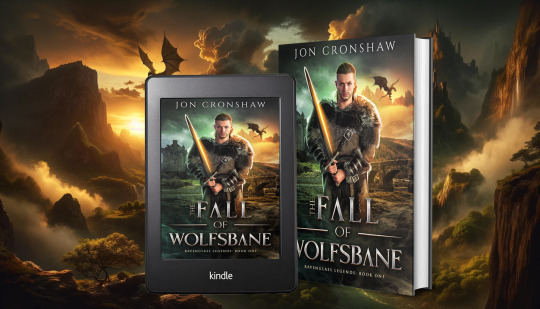
View On WordPress
#classic fantasy movies#digital era fantasy films#evolution of fantasy cinema#fantasy cinema evolution#fantasy cinema history#fantasy directors#fantasy film technology#fantasy filmmaking#fantasy genre analysis#fantasy in cinema#fantasy movie effects#fantasy movie timeline#fantasy visual effects#history of fantasy films#iconic fantasy films#influential fantasy movies#modern fantasy movies#silent era fantasy films#top fantasy movies
0 notes
Text
cool neat fact about true detective s1 (if you didn't already know!) is that all of the 1995 sequences were filmed on physical film and weren't filmed in popular/contemporary digital format. the 2002 era onward was all filmed digitally, so you may have noticed a subtle shift in the atmospheric quality of the cinematography. genius choices. peak cinema. and every time I rewatch the 1995 sequences I can't believe how gorgeous they are, how the film adds this silent layer of ambiance. you can sense it in a strange way that adds to the viewing experience. good shit!
edit as of may 2024: I had to come back on here and do some minor course correction, because back in the distant epoch of 2014 there was some popular misinformation going around online (between here and reddit, I believe) at the time about the era-specific filming nuances and my grizzled memory did not understand the full scope of the actual filming technique. APPARENTLY, the entire season was indeed shot on 35mm film on a vintage camera (adam arkapaw you will always be famous), but they specifically changed the lenses used on the camera to depict subtle differences in the picture and cinematic experience between 1995/2002 and then later in 2012. the more you fucking know
959 notes
·
View notes
Text
An argument I hear from time to time is the following:
"I don't care that this novel is considered Legends, if it was canon when George Lucas was in charge of Lucasfilm, it's still canon to me now. Whatever George says is what counts, I don't care what Disney says."
Putting the Expanded Universe's Star Wars and George Lucas' Star Wars in the same basket. And that's, uh... inaccurate.
So without further ado, let's explore:

George Lucas’ involvement in the Expanded Universe
Early years of the EU...
When the first bit of EU content came out in the form of the novel Splinter of the Mind's Eye, Lucas was too busy working on the films, so Alan Dean Foster wrote it by himself (which explains why Luke and Leia's relationship plays out romantically).
After the movies came out, when new material was going to be created, George told Lucas Licensing and other authors that the Prequel era was off-limits to write about, because he might tell that story one day.
Beyond that, they could go to town and write sequels, for instance. After all, part of why Star Wars was created was to let people's imagination run wild and George was happy to let other artists play in the sandbox he created.
That said, things were very clear from the get-go.
These weren't his stories.
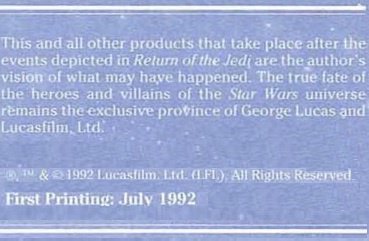
The Thrawn books, Dark Empire, all this material was explicitly just Tom Veitch and Timothy Zahn and whoever else's creation. Not George's, who was described by Lucas Licensing's Lucy Autrey Wilson as "not very involved".
The most he did was answers "OK/Not OK" questionnaires about what the EU writers could or couldn't write.
Telling Yoda's backstory? Not OK.
Telling Han's backstory, between the Prequel and Ep. 4? OK.
Having someone wear Vader's suit after his death? Not OK.
The Emperor returning in a clone body? OK.
So that's it. That was his involvement in the 90s.
Him saying "don't write something set during this/that period".
"OK/Not OK" questionnaires.
It's also worth mentioning he didn't approve of Mara Jade, Luke's wife in the EU. In his mind, "Jedi don't marry".

Rather, the character herself wasn't an issue... until she married Luke. When Timothy Zahn asked for Luke and Mara to be married or engaged, back in 1993, Lucasfilm initially vetoed the idea.
According to Brian Jay Jones (author of "A Life", George Lucas' biography), in 1995 George convened a 'Star Wars Summit' wherein he gathered licensees and international agents to Skywalker Ranch to reinforce "the need for him to maintain quality control, especially in the areas of publishing, where some characters—such as Luke Skywalker, who’d been given a love interest in a fiery smuggler named Mara Jade—were living lives far beyond the ones he had written for them in the original trilogy".
Sources:
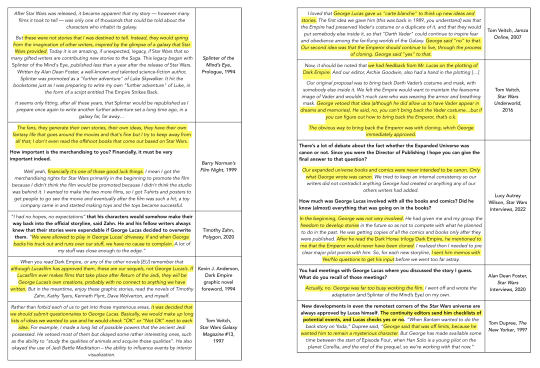
During the Prequels...
George Lucas was writing and directing three movies with large themes, shot almost back-to-back, commuting between Australia and California. That's hard enough as it is.
Also, in the 90s, most movies were still shot on film. During the making of Phantom Menace, Lucas shot parts of the film by combining prototype digital Sony cameras and using them in combination with videotapes, rather than shooting on film.
For Attack of the Clones, George worked with Panavision and Sony to develop fully digital cameras, which eventually became the standard.
As if that wasn't enough, by making the Prequels, Lucas and ILM were also creating fully-digitized worlds (Coruscant, Geonosis) and characters (Jar Jar, Yoda) and laying the groundwork for the CGI technology that has now become essential for today's blockbusters.
Having established all this...
Do you really think he had the time or the patience to read through a bunch of novels and guidebooks?!
Simply put: George Lucas was too busy revolutionizing cinema to be involved in the development of the EU.
So if you ask George who Tahl or Vitiate are, or what the Stark Hyperspace War or a vapor manifold are, if you ask him to recite you the Sith Code... he'll grumble and say "heck if I know".
He outright admitted that fans know more Star Wars lore than him.
Because SOMEBODY ELSE wrote that stuff.
And he let them do it because:
It made money. A lot of money, especially after TPM came out. Money that could fund his next films. You don't mess with licensing. Hell, it's why he was so cool with there being all those Star Wars parodies.
He didn't see those stories as canon anyway, so it couldn't hurt. He saw them as a separate universe, an alternate timeline wherein the films happened ALONG with all these other tales.
So associating the EU content with Lucas is unreasonable. He was too busy, so he just let Howard Roffman, Lucy Autrey Wilson, Sue Rostoni and Lucas Licensing do their thing and crank out new stories and transmedia content for the fans.
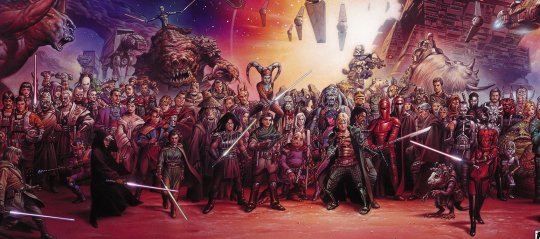
It was a one-way relationship. The licensing parallel universe needed to have some internal consistency AND adhere to what Lucas established in the new films movies (which was difficult because they weren't involved in the production process), but he didn't need to be in line or consistent with anything they established.
Now, George did set some guidelines/boundaries and there were obviously do's and don'ts. But once those boundaries were set and the brief was established, the authors had a lot of freedom and, like, 99% of their interaction was with their editors from the respective publishing houses (Scholastic, Del Rey, Dark Horse) and the folks at Lucas Licensing.
George was only really brought in to sign off on, like, some of the major plot points only once in a blue moon. Stuff like:
"Let's make a Maul novel".
George would go "fine, just keep him mysterious."
"What species should Plagueis be?"
George: "he could be a Muun, here's concept art."
Nothing more than that. Again: the Expanded Universe was other storyteller's interpretation of what Lucas had created.
Sometimes, it was spot on and it aligned with George's vision.
Other times, this additional lore was created by writers who didn't know what he was doing with the Prequels, so they were in the dark regarding certain plot points.
And then you have the authors who absolutely disagreed with George's vision of the Prequels, or of Star Wars, in general, but wanted to engage with the material nonetheless.
Which is why, whilst sometimes the EU fixed some plot-holes, sometimes the EU had inconsistencies.
Inconsistencies such as Ki-Adi Mundi being a Knight on the Council, who is married and has kids (when the Jedi being prohibited from marrying is a major plot point in the Prequels)...
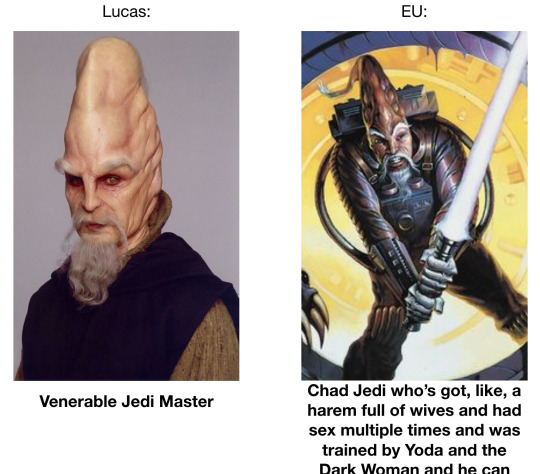
… or the Jedi being essentially superhuman (when one of the narrative reasons Qui-Gon is killed is to show that the Jedi are mortals, not supermen)…
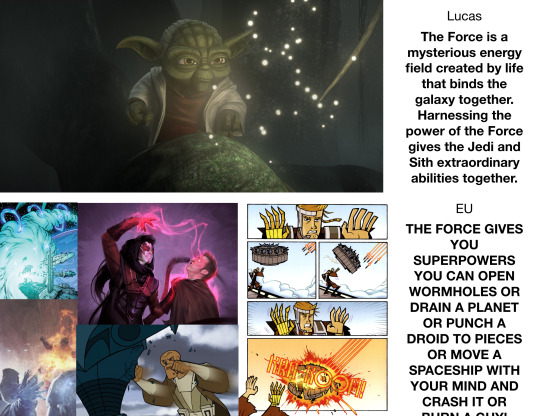
... or other stuff like Mace having a blue lightsaber for a period (because who the hell knew purple was an option?!) or some Jedi having red lightsabers, or Sith Lords being able to become ghosts after death, when that's a feat you can only achieve by being selfless.
It's also why you get conflicting definitions of what the Jedi call "attachment" or conflicting narratives trying to reframe midi-chlorians as a cold, intentionally-flawed way of seeing the Force (when they're meant to be a beautiful metaphor for symbiosis and how the Force works).
And it makes sense that some of this stuff wouldn't track, considering how Lucas stated multiple times that he didn't have anything to do with it, that it was a separate universe from his own...

Safe to say that if George had any involvement in the EU, it was so minimal that he, himself, didn't count it as "involvement".
Additional sources:
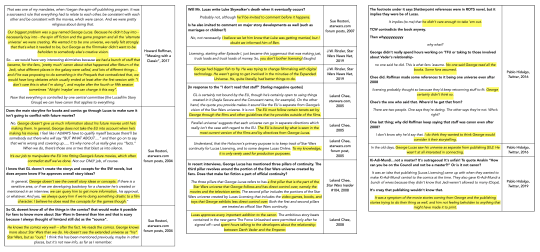
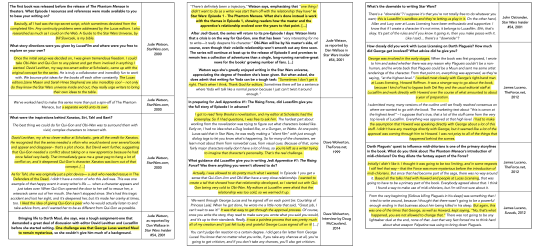
Later years of the EU...
After the Prequels were over and done with, Lucas created The Clone Wars with Dave Filoni. At first, he'd just suggest a few storylines, but he quickly got VERY involved in the whole process. Far more involved than he ever was with EU content.

And y'know... Dave Filoni is a massive Star Wars fan and an avid EU reader. So, from time to time, Filoni would bring up EU material for Lucas to consider during the story conferences, and they'd look at what was out there together.
But it's important to note that George's stance toward the EU didn't change and became a rule for everyone on the writing staff: the EU content was nothing more than a pool of "fun what-if ideas" that they could draw inspiration from.
If they could, they'd try to not mess with continuity... but if the story called for it, they could retcon anything without batting an eye. Because it wasn't canon to them.
It's why author Karen Traviss quit working with Lucasfilm after the Mandalorians were retconned into pacifists in The Clone Wars.
youtube
The only things that were truly canon were:
George Lucas' own word.
The movies.
Previously established The Clone Wars lore.
And that's it.
Everything else was somebody's else's concern. Not George's.
Sources:



This way of seeing the EU continued all the way to the time shortly before George sold the company to Disney as his drafts for the Sequels featured:
no Jacen, Jaina or Anakin Solo (Han and Leia's kids from the EU),
a still-alive Chewbacca (who died, later in the EU),
no "New Jedi Order".

Every version of George's Sequels ignored the EU.
Which would explain why the EU reboot was planned in the summer of 2012 (when Lucas was in charge)!
I'll repeat: the EU reboot was planned months BEFORE George Lucas sold the company to Disney.
Because of course it was! It's a natural result of 30 years' worth of content that's so intermeshed that it would stop future artists - namely George himself - from creating anything else.
Sources:
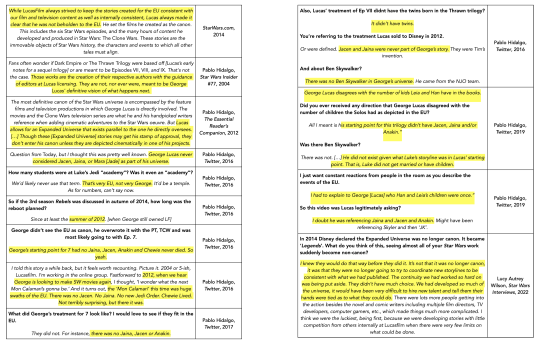
Exceptions to the rule:
1. Comics (kinda)
He did read the comics. Or at least, he gave them a glance.
Aside from the fact that he grew up reading comics, understand that George Lucas is a visual artist, first and foremost.
That's what he's about and that's what he loves, that's what speaks to him. There's a reason his upcoming Museum of Narrative Art will feature comic panels and pages of all kind.
During pre-production on Attack of the Clones and Revenge of the Sith, Lucas had the art team draw concept art before a script had ever been written so he'd have ideas for set-pieces.

Later on, J.W. Rinzler pitched him the idea of adapting his early drafts for Star Wars into comic form. Lucas' initial reaction was going "hell no". Rinzler had concept art made…
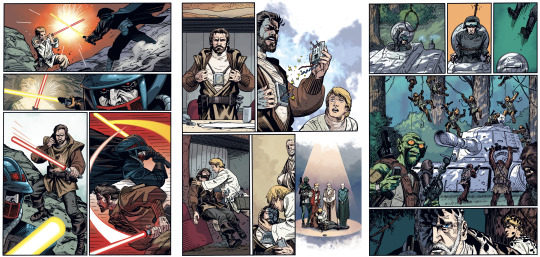
… and George took one look and was on board.
So it's not a stretch to assume that a book telling a story through beautiful drawings would catch his attention more than a novel.
Case in point: He knew who Quinlan Vos was and was enamored with the character. He knew Aayla enough to put her in Attack of the Clones after seeing a cover of Republic by John Forster featuring her (below, left).
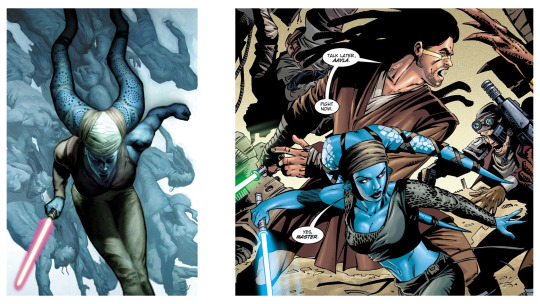
(although, it's worth pointing out that he doesn't call her out by name a single time, in the director's commentary of the Attack of the Clones, she's just the "Twi'Lek Jedi" and her inclusion was done mainly to add more diversity to the Jedi fighting in the arena)
Over a decade later, when the comic Star Wars #7 came out in 2015, Lucasfilm acquired artist Simone Bianchi's original 20 pages and cover art for George, so he could feature it in his the Museum of Narrative Art:

So at the very least, he looked at the comics and admired the visuals.
Whether he actually read the comics in detail or just skimmed through most of them because he liked the pretty pictures (likelier, imo) is an entirely different matter.
Sources:

2. Video-Games (kinda)
Lucas would periodically check in on the status of LucasArts games, lending creative input and advice.
Sometimes, his advice ranged from "weird" to "he's gotta be fucking with us, right?"

Apparently, he advised the team developing Star Wars: The Force Unleashed that they dub Starkiller "Darth Insanius" or "Darth Icky".
And you know what? I have no trouble believing it.
Firstly because if you're going by the idea that he gave no fucks about the EU, then of course he'll come up with "meh" names. But also, this is the same guy who created "Winkie" in 2012/2013, the character who'd go on to be named "Rey".

He also told the team creating Star Wars: 1313 that he wanted a fresh face as the main character, then only weeks before the game was announced he went "let's make it Boba Fett".
Finally... the cancelled Darth Maul game by Red Fly.
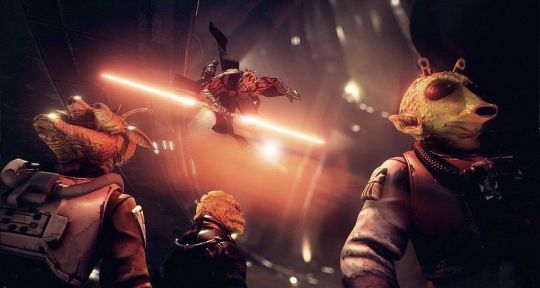
Codenamed “Damage”, then “Battle of the Sith Lords”. Think Batman: Arkham City meets Star Wars.
Red Fly pitched it as a coming of age story where we see Maul be kidnapped, tortured, eventually joining the Dark Side, and ending in TPM. Then they had interactions with LucasArts and found out Maul survived his fight with Obi-Wan.
The game went through several iterations, partly because the people at Red Fly were kept in the dark about the developments in The Clone Wars (Season 4 wasn't out yet), and even when some tidbits came out and they knew characters like Savage Oppress and Death Watch would be included, they didn't get more details.
youtube
Whatever. They do their best to make something from what they're told. Then they have a meeting with George. As this GameInformer article explains:
“A friendly George Lucas entered the room and was eager to hear the pitch from Red Fly’s creatives. “Before they could finish their spiel, Lucas cut them off, stood up, walked over to [two Sideshow Collectibles statues of Darth Maul and Darth Talon], rotated them to be facing the same direction, pushed them together, and said ‘They’re friends!’” adds the source. “He wanted these characters to be friends, and to play off of each other. […]
The problem with the idea of Maul and Talon teaming up for a buddy cop-like experience was that they were separated by over 170 years […]
When this vast time divide was brought up to Lucas’ attention, he brushed off the notion of it not working, and said that it could instead be a descendant of Darth Maul or a clone of him.”
So now the game is about a descendant of Maul, guided by his ancestor and fighting a redesigned Darth Krayt, etc?
The game was eventually cancelled when George sold the company.
Worth pointing out that this was circa 2010/2011... around the time that George started working on his Sequels, according to Jett Lucas. And we know that the treatment for the Sequels that Lucas presented to Bob Iger featured old man Maul and Darth Talon as the villains of the trilogy... take from that what you will.
3. The Prequel novelizations (kinda)
They were all given a copy of Lucas' screenplay.
While most of their work was with Sue Rostoni, Lucy Autrey Wilson, and Howard Roffman on the Lucasfilm team (like some of the other authors), Terry Brooks, R.A. Salvatore and Matthew Stover all spent a bit of time with George before writing their respective novels.
George told Terry Brooks to write some additional material for Anakin Skywalker because there wasn't enough of that in the movie. He was shown rushes from the set, they "opened the safe" for him. When Terry had further questions re: midi-chlorians and the history of the Sith, George goes on a 30-minute monologue about all that.
R.A. Salvatore had a 45-minute interview with him that turned into a 3-hour chat. He was able to go back to the Ranch a few times during the writing process, and one of those times George chatted with him and his wife during lunch. He was shown various cuts of the film and concept art.
Matthew Stover and George talked for a whole afternoon (I'm gonna go out on a limb and assume he was also shown the other stuff like some cuts/deleted scenes, concept art, etc etc).
Was there a line-edit of the ROTS novel from Lucas?
Regarding the Revenge of the Sith novelization, some people bring up the idea that George Lucas did a line-edit on the book because Stover wrote this statement on theforce.net:
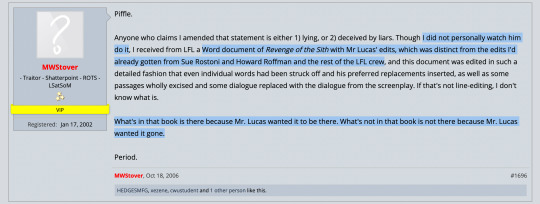
That said...
Stover, also stated that Lucas told him to write whatever he wanted as long as it was good,
he also said he didn't actually see Lucas type the edits,
an anonymous Del Rey editor stated on theforce.net that the notion that George edited the novel himself is "extremely incorrect".

There's enough "reasonable doubt" for the argument to be made that the Revenge of the Sith novelization was edited the same way as any other Star Wars novel, rather than by George himself.
The fact remains, though, that it was a novel written by someone who understood the source material, as it was explained to him in detail by George Lucas himself (a luxury many SW authors never got).
Lucas' backstory for the Sith in the TPM novel:
If Pablo Hidalgo is to be believed, the backstory of the Sith, as detailed in the Phantom Menace novelization, came from Lucas.
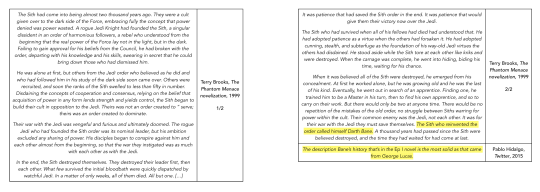
(Obviously, I'd allow for the very likely possibility that there was some embellishment by Terry Brooks)
20 years later, however, it seems George decided to stick to the idea that there was no war between the Jedi and the Sith.

Final thought:
A lot of people will insist that George was involved in spite of all the above-posted evidence. Saying stuff like:
"But [X person] said that it was canon..."
Sometimes, they’ll link you to this whole website collecting quotes of other people saying "the EU was canon" (never George Lucas except for, like, one/two quotes where he acknowledges the existence of Sequel books which MUST mean he saw them as canon, right?) and...
On the one hand... of course they'll all vaguely say he's "involved" and tip-toe around the subject; it's technically true and, again, they're trying to make money. It's a business, folks.
On the other... yeah? Duh. Of course it was canon to Lucas Licensing and the authors who wrote for the EU. But it wasn't canon to George. And I just gave you a whole bunch of quotes directly from him and/or the same people quoted on that website, all confirming that he didn't see them as canon and he wasn't involved (or barely was).
Other times, we're straight-up approaching "burying head in the sand/lalalala I'm not listening!" levels of justifications.
Like, we just talked about the Sith's origins, right?
I remember a while ago, this Star Wars YouTuber was reviewing this quote from Lucas, in The Star Wars Archives: 1999-1995:

The YouTuber's reaction the second after reading the quote is saying:
"And of course, what George is referring to, here, is the Battle of Ruusan and the Brotherhood of Darkness using the Thought Bomb created by Lord Khan to kill the Jedi Lord Hoth and…"
My guy! You read a whole excerpt that started with "there was never a war between the Jedi and the Sith" and the words "Ruusan" or "Thought Bomb" never being mentioned once in the passage (or in the TPM novelization)... and concluded that George was referring to the Jedi/Sith Battle of Ruusan? And all that other EU stuff?
See what I mean, folks?
Now, look, I grew up with these stories (heck, I grew up with these stories in three different languages). So I get it. I know they're awesome.
And, yes, there is a difference between the kind of content we used to get and the content we're getting now (for one, lightsabers used to be lightsabers, in video-games, not baseball bats).
But if you're trying to prop up the EU, the facts show that the "George Lucas signed off on them" authority argument isn't a valid one. Because he clearly wasn't very interested or involved in it.
And why would you want to use this authority argument, anyway?
You shouldn't need to say "this came from Lucas" to like those stories. They don't need to be George Lucas Approved™ to matter and to be validated as "worthy of appreciation". They're valid on their own, they're great stories. And if you like them better than the Sequels, go to town. I know I do.
The only thing you can't do (with a straight face, at least) is hold them up as "the True Lucas-Approved Canon™ as opposed to the Disney Trash" in a rant, because you'd be wrong and/or lying. Neither had Lucas' hand in them in any meaningful way.
Finally... I was devastated when the EU was officially made non-canon, in 2014. And for a few years, I saw the new Star Wars continuity through this lens:
"Any EU content is still canon unless it's directly retconned...!"
Trust me, when I say that only pain lies that way. Because that's not how a lot of Star Wars creators, including the Flanelled One himself, see it. The way they saw/see it is:
"Unless it's been shown in a movie or TCW... it's a legend, it might have happened."
This line of thought seems to be increasingly applied to the new Disney canon too, by the way. "If it's not shown on a screen, then it's probably canon yet also up for grabs to be retconned."
And the sooner you accept that this is how it's being treated, the sooner you accept that the EU was never canon to Lucas or Filoni...
... the less painful it'll be when, I dunno, you watch The Acolyte and it's nothing like the Darth Plagueis novel or Plagueis himself is absent, or he's there, but as an Ithorian instead of a Muun.

(note how I didn't use the word "painless")
#Lucas Canon & EU Canon & Disney Canon are all different things.#the only downside to this notion is that you can't use Lucas' name in conjunction with the EU to win a debate or rant about LF.#or use Lucas' name to validate a headcanon that came from the EU#Aside from being glad he got to create a universe that inspired so many artists and creators to let their imagination go wild#he barely gave a crap about what other writers did in a parallel universe that he didn't even see as canon.#and that's FINE#collection of quotes#89 quotes I think#this may be the longest or second post I've written yet#meta#sw meta#expanded universe#george lucas#lucas quotes#dave filoni#youtube#star wars#star wars analysis#TCW#star wars comics#star wars novels#lucasfilm#EU#Legends#star wars legends#sw legends#supplementary material#long post
874 notes
·
View notes
Text
In Hollywood, the present is the future is the past.
Twin strikes shut down production for six months last year, and with its workforce still on ice, the entertainment industry has been slow to recover. Domestic box-office revenue is expected to be 30 percent lower this year compared to 2019. By 2028, cable TV subscriptions are expected to decline by 10 million. And with the looming acquisition of Paramount Global by Skydance Media, the future of Hollywood is as it ever was: reliably uncertain. As one studio executive described it to the Los Angeles Times, it’s “something of an existential question mark.”
Of course, this isn’t Hollywood’s first—or second or third, for that matter—financial reckoning. “When we look closely at history, we realize that all the negotiations we have to make about character, about financing, about representation and all these things have been asked before,” says Maya Cade. “Ego tells us that we must be the first, but why would we want that to be true?”
This, in part, was Cade’s mission when she launched Black Film Archive in 2021. At a “moment when people were demanding the full totality of our lives to be represented in media,” she says, “they felt as if Black film could not hold the capacity for Blackness.” Cade knew better. So she got to work and built what is now the most exhaustive online database of Black cinema titles, spanning diverse, obscure, and well-known films.
A former audience development strategist at the Criterion Collection, she tells me people were missing a larger context to the issues at hand. The archive, which celebrated its third anniversary this August, features more than 300 films released between 1898 to 1999, with each title available to stream online. What Cade has accomplished is both rare and essential: She has indexed a century's worth of Black moviemaking and made it free to access.
Anxious to learn more, I reached out to Cade to help make sense of what’s happening in Hollywood. Over the phone from Los Angeles, where she recently relocated, Cade and I talked about the fate of the entertainment business, the grave implications of the Internet Archive lawsuit, and how we can better preserve history on an internet that likes to forget.
Jason Parham: Is it true that the idea for Black Film Archive sprang from a conversation on Twitter?
Maya Cade: I was on Twitter in June 2020, and I saw a lot of people talking about how racist or dramatic Black films are as a way to dismiss them. So instead of shaming people for that opinion, in my mind I was like, OK, how do I make an offering for people to discuss that belief, to contrast that belief, and also move us past it. I don't want to dismiss the truth because it's harsh. And I know there are many ways to get to the truth. I also don’t want to dismiss people who feel that way. But I want to offer another lens of how they're seeing it. Because when we talk about Black films as only being traumatic, we're reducing the art form in a very minuscule kind of way. This idea of like, “Oh, all these films are about slavery. All of these films are about trauma porn.”
Which, of course, isn’t true.
I did the calculations of how many films are about slavery—and they were quite few across time. But I understand that at the same time, what does it mean when a white decisionmaker wants to see Black people in a specific way? They have the power of how we're told in media. I also understand that film becomes the dominant narrative of how history is told. So there are multiple truths to contend with. But I think we're better prepared to contend with those things when we have a full look of what Black film’s history can offer.
The Internet Archive recently lost an appeal, which could have major ramifications to how we access information. Resources like Black Film Archive and the Wayback Machine are also part of this conversation. This is a bit of an abstract question, but how do we better hold on?
One goal of the early internet was to democratize knowledge. Whether everyone agreed with that is a different point. And the Internet Archive is one of the only things from the early internet to still exist in its same way. Wikipedia, too. These two things are constantly under attack, because to share knowledge freely means that someone wants to come in and control the free flow of knowledge. They want to profit from that.
In so many ways greed has become a default response to various public resources.
With that being known, what do we do? The world has been upended. The only truth that we know is in books. On the internet, AI has turned knowledge upside down. AI leaves out the essence of truth. For example, through summary, it assumes who you are and what you want to know quickly about something, which isn't the same as a human would do it. That process can remove layers of truth at a very basic level. With that being the foundation of the internet of the future, the Internet Archive is essential. In the last 10 years, we have moved away from the internet as a service to the internet of things. An internet as service—it was a destination. It was a place that you could freely roam, explore, and use as a guide.
Is there a way back to that?
If we want places on the internet that aren't run by AI, where knowledge is freely shared, where we can explore as we desire, then we must invest our time, our coins, we must advocate and protect as much as we possibly can. There’s so much on the internet that would crumble if the Internet Archive or Wikipedia falls. That's a threat to many people because, ultimately, when you control the flow of knowledge, you control everything.
The consequences would be extraordinary.
It's almost as if the basic concept of the library would be a pie-in-the-sky idea today, because someone would ask, well, how could I make money from that? When Black Film Archive launched, many people wanted to profit off of it. Many people asked to sponsor it. The thing is, once you create something that becomes a front line of culture, the question isn’t “How do I help sustain you?” The question is “How do I own you?” I said no because I’m firm in Black Film Archive being free.
On the subject of money and ownership: Earlier this year, following the cancellation of several Black TV shows, you wrote, “Studios and streamers no longer care about loyalty or enduring legacy.” Why does Hollywood, in 2024, still have such a difficult time aligning its legacy with its business?
Well, here's the thing, the legacy business, they feel as if that work is behind them.
But isn’t that what Hollywood is built on?
Yes, but to create new legacy and new inroads, to them, that is less important than extracting every possible dollar from existing IP. It’s more “expensive,” quote-unquote, to create something than it is to rest on existing laurels. The beginning of the end of this, to me, was when Warner Brothers and UPN merged into The CW. Now, 20 years later, the CW is a shell of itself. In mergers, you're no longer competing with someone to make the best content. With the merger of Warner Brothers and Discovery, they own, what, one-fourth of TV? That competition era of television—it's over.
Which has a direct impact on the creative side.
The legacy-driven model only happens now in vanity. So a lot of stars are using their own distribution or first-look deals to produce things. And these are the majority of people who are allowed to create. So what does Hollywood mean when the only people who are given freedom are people who have already done the taxing work—if they have at all—to become stars? Hollywood is not in the business of guarantee. Everything must be proven before it's even created.
And if that’s the case, so many people get left out.
And if everything must be proven before it's even created, then Blackness never had a chance. It doesn't have a chance. The fight for nostalgia as currency comes in a moment where some of the highest rated things are non-white. That's not an accident. It’s as if television, media, and filmmaking are becoming manifest destiny in the wrong ways. And there's nothing sadder.
Perhaps we need better frameworks.
People have upended industries to chase Netflix. And no one has caught up. Everything has fallen in this chase. What’s happening now is, people are only duplicating the best and the most watched. There is no diversity in how things are being delivered.
You once described “post-2020 Black media as akin to a modern day blaxploitation boom.” It got me thinking about platforms like Tubi and AllBlk, which are sometimes mocked as being a kind of streaming ghetto, but those same streamers have also given opportunities to young creators.
Blaxploitation, as I was saying, makes way for Spike Lee, it makes way for the '80s independent Black movement that, of course, shapes everything we know about modern Black film and modern Black media. At every valley, there is a peak. It’s the nature of life. So what do I think is ahead? We should be thinking about independent models that have existed before our current era. There are many ways to make media. With pilot season essentially dying, as the studios have announced, what are some ways that Black creators can forge together to make what they desire?
I mean, I don't know if I have the answers, but I do have the curiosity. And oftentimes curiosity and care—and leading with them—can transform how we understand history and the future.
21 notes
·
View notes
Text
You like reading fanfics? How about reading about fanfics? 😏
Here’s what I've read so far (or am currently getting through) for my dissertation on fanfiction bookbinding! I'll be updating it as I go until the end of July. If you have any recs to add to the towering pile or any questions/opinions about something on there, I’m all ears!
on fan studies & ficbinding ✔
Alexander, Julia, ‘Making fanfiction beautiful enough for a bookshelf’, The Verge, 9 March 2021 <https://www.theverge.com/22311788/fanfiction-bookbinding-tiktok-diy-star-wars-harry-potter-twitter-fandom> [accessed 12 June 2024]
Buchsbaum, Shira Belén, ‘Binding fan fiction and reexamining book production models’, Transformative Works and Cultures, 37 (2022)
Dym, Brianna, and Casey Fiesler, ‘Ethical and privacy considerations for research using online fandom data’, Transformative Works and Cultures, 33 (2020)
Jenkins, Henry, Textual Pochers: Television Fans and Participatory Culture (New York: Routeledge, 1992)
Jenkins, Henry, ‘Transmedia Storytelling 101’, Pop Junctions, 21 March 2007 <http://henryjenkins.org/2007/03/transmedia_storytelling_101.html#sthash.gSETwxQX.dpuf> [accessed 12 June 2024]
Hellekson, Karen, ‘Making Use Of: The Gift, Commerce, and Fans’, Cinema Journal, 54, no. 3 (2015), 125–131
Kennedy, Kimberly, ‘Fan binding as a method of fan work preservation’, Transformative Works and Cultures, 37 (2022)
Minkel, Elizabeth, ‘Before “Fans,” There Were “Kranks,” “Longhairs,” and “Lions”: How Do Fandom Gain Their Names?’, Atlas Obscura, 30 May 2024 <https://www.atlasobscura.com/articles/fandom-names> [accessed 12 June 2024]
Penley, Constance, Nasa / Trek: Popular Science and Sex in America (London: Verso, 1997)
Price, Ludi, ‘Fanfiction, Self-Publishing, and the Materiality of the Book: A Fan Writer’s Autoethnography’, Humanities, 11, no. 100 (2022), 1–20
Schiller, Melanie, ‘Transmedia Storytelling: New Practices and Audiences’, in Stories: Screen Narrative in the Digital Era, ed. by Ian Christie and Annie van den Oever (Amsterdam: Amsterdam University Press, 2018), 99–107
on folklore, the internet, other background reading ✔
Barthes, Roland, ‘La mort de l’auteur’ in Le Bruissement de la langue: Essais critiques IV (Paris: Éditions du Seuil, 1984)
Blank, Trevor J., Folklore and the Internet: Vernacular Expression in a Digital World (Logan, Utah: Utah State University Press, 2009)
Mauss, Marcel, ‘Essai sur le don. Forme et raison de l’échange dans les sociétés archaïques.’, L’année sociologique, 1923–1924; digital edition by Jean-Marie Tremblay, Les classiques des sciences sociales, 17 February 2002, <http://classiques.uqac.ca/classiques/mauss_marcel/socio_et_anthropo/2_essai_sur_le_don/essai_sur_le_don.html> [accessed 10 June 2024]
McCulloch, Gretchen, Because Internet: Understanding How Language is Changing (Random House, 2019)
Niles, John D., Homo Narrans: The Poetics and Anthropology of Oral Literature (University of Pennsylvania Press: Philadelphia, 1999)
hopefully coming up next (haven't started yet)
A Companion to Media Fandom and Fan Studies, ed. by Paul Booth (Hoboken: John Wiley & Sons, Inc., 2018)
A Fan Studies Primer: Method, Research, Ethics, ed. by Paul Booth and Rebecca Williams (Iowa City: University of Iowa Press, 2021)
Dietz, Laura, ‘Showing the scars: A short case study of de-enhancement of hypertext works for circulation via fan binding or Kindle Direct Publishing’, 34th ACM Conference on Hypertext and Social Media (HT ‘23), September 4–8, 2023, Rome Italy (ACM: New York, 2023)
Fathallah, Judith May, Fanfiction and the Author: How Fanfic Changes Popular Cultural Texts (Amsterdam: Amsterdam University Press, 2017)
Finn, Kavita Mudan, and Jessica McCall, ‘Exit, pursued by a fan: Shakespeare, Fandom, and the Lure of the Alternate Universe’, Critical Survey, 28, no. 2 (2016), 27–38
Hjorth, Larissa et al., eds. The Routledge Companion to Digital Ethnography (New York: Routledge Taylor & Francis Group, 2017)
Jacobs, Naomi, and JSA Lowe, ‘The Design of Printed Fanfiction: A Case Study of Down to Agincourt Fanbinding’, Proceedings from the Document Academy, 9, issue 1, article 5
Jenkins, Henry, Convergence Culture: Where Old and New Media Collide (New York: New York University Press, 2006)
Jenkins, Henry, Spreadable Media: Creating Value and Meaning In A Networked Culture (New York: New York University Press, 2013)
Kennedy, Kimberly, and Shira Buchsbaum, ‘Reframing Monetization: Compensatory Practices and Generating a Hybrid Economy in Fanbinding Commissions’, Humanities, 11, no. 67 (2022), 1–18
Kirby, Abby, ‘Examining Collaborative Fanfiction: New Practices in Hyperdiegesis and Poaching’, Humanities, 11, no. 87 (2002), 1–9
Kustritz, Anne, Identity, Community, and Sexuality in Slash Fan Fiction (New Work: Routeledge, 2024)
Lamerichs, Nicolle, Productive Fandom: Intermediality and Affecive Reception in Fan Cultures, (Amsterdam: Amsterdam Universtiy Press, 2018)
Popova, Milena, ‘Follow the trope: A digital (auto)ethnography for fan studies’, Transformative Works and Cultures, 33 (2020)
Rosenblatt, Betsy, and Rebecca Tushnet, ‘Transformative Works: Young Women’s Voices on Fandom and Fair Use’, in eGirls, eCitizens: Putting Technology, Theory and Policy into Dialogue with Girls’ and Young Women’s Voices, ed. by Jane Bailey and Valerie Steeves
Soller, Bettina, ‘Filing off the Serial Numbers: Fanfiction and its Adaptation to the Book Market’, in Adaptation in the Age of Media Convergence, ed. by Johannes Fehrle, Werner Schäfke-Zell (Amsterdam: Amsterdam University Press, 2019), 58–85
#fanbinding dissertation#fanbinding lit#bibliography#dissertation#reading list#gradblr#study blog#research#fanfiction#bookbinding#fanbinding#ficbinding#fanfic#ethnology#folklore#currently reading
43 notes
·
View notes
Text
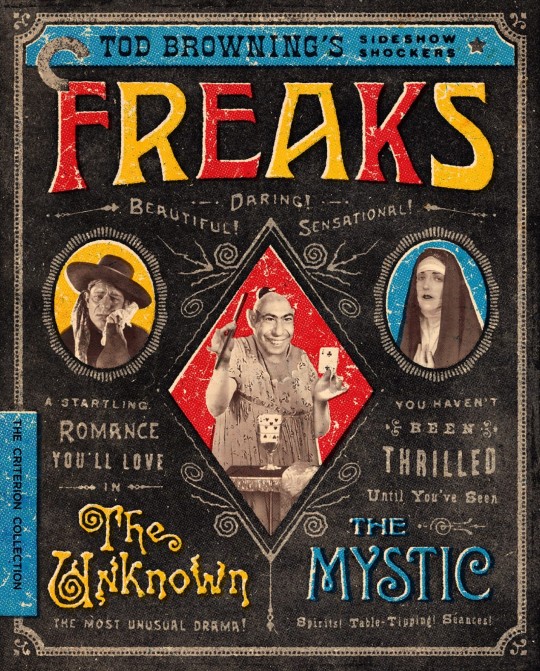
Tod Browning's Sideshow Shockers will be released on Blu-ray and DVD on October 17 via The Criterion Collection. The set collects three films directed by Tod Browning: Freaks, The Unknown, and The Mystic.
Freaks (also known as The Monster Story, Forbidden Love, and Nature's Mistake) is a 1932 horror film written by Willis Goldbeck and Leon Gordon. Wallace Ford, Leila Hyams, Olga Baclanova, and Roscoe Ates star.
The Unknown is a 1927 silent horror film written by Waldemar Young. Lon Chaney, Norman Kerry, Joan Crawford, and Nick De Ruiz star.
The Mystic is a 1925 silent drama film written by Browning and Young. Aileen Pringle, Conway Tearle, and Mitchell Lewis star.
Freaks has been digitally restored in 2K with uncompressed monaural sound. The Unknown has been digitally reconstructed and restored in 2K with a new score by composer Philip Carli. The Mystic has been digitally restored in 2K with a new score by composer Dean Hurley.
Raphael Geroni designed the cover art. Special features are detailed below.
Special features:
Freaks audio commentary by film scholar David J. Skal
The Unknown audio commentary by film scholar David J. Skal
The Mystic introduction by film scholar David J. Skal
Interview with author Megan Abbott about director Tod Browning and pre-Code horror (new)
Freaks archival documentary
"Spurs" - Reading of Tod Robbins' short story on which Freaks is based
Freaks prolgue, added to the film in 1947
Freaks alternate endings featurette
Freaks portrait video glalery
Essay by film critic Farran Smith Nehme

The most transgressive film produced by a major American studio in the 1930s, Tod Browning’s crowning achievement has haunted the margins of cinema for nearly one hundred years. An unforgettable cast of real-life sideshow performers portray the entertainers in a traveling circus who, shunned by mainstream society, live according to their own code—one of radical acceptance for the fellow oppressed and, as the show’s beautiful but cruel trapeze artist learns, of terrifying retribution for those who cross them. Received with revulsion by viewers upon its initial release, Freaks effectively ended Browning’s career but can now be seen for what it is: an audacious cry for understanding and a singular experience of nightmarish, almost avant-garde power.

The most celebrated and exquisitely perverse of the many collaborations between Tod Browning and his legendary leading man Lon Chaney, The Unknown features a wrenchingly physical performance from “the Man of a Thousand Faces” as the armless Spanish knife thrower Alonzo (he flings daggers with his feet) whose dastardly infatuation with his beautiful assistant (Joan Crawford)—a woman, it just so happens, who cannot bear to be touched by the hands of any man—drives him to unspeakable extremes. Sadomasochistic obsession, deception, murder, disfigurement, and a spectacular Grand Guignol climax—Browning wrings every last frisson from the lurid premise.

A fantastically atmospheric but rarely seen missing link in the development of Tod Browning’s artistry, set amid his favored milieu of shadowy sideshows and clever criminals, The Mystic provides a striking showcase for silent-era diva Aileen Pringle, who sports a series of memorably outré looks (courtesy of art-deco designer Erté) as Zara, a phony psychic in a Hungarian carnival who, under the guidance of a Svengali-like con man (Conway Tearle), crashes—and proceeds to swindle—American high society. Browning’s fascination with the weird is on full display in the eerie séance sequences, while his subversive moral ambiguity extends surprising sympathy to even the most seemingly irredeemable of antiheroes.
#tod browning#freaks#the unknown#the mystic#criterion#the criterion collection#criterion collection#dvd#gift#raphael geroni#horror#classic horror#lon chaney#joan crawford#silent horror
119 notes
·
View notes
Text
Ext. Restaurante Bel'mar - Dia
Pedro está sentado numa mesa com paisagem para a praia. Está bom tempo e bebe uma bebida fresca. Enquanto isso escreve no seu tablet.
Pedro
Na vida, adquirir mais conhecimento e experiência nunca é demais. E é isso que eu penso adquirir com o meu PMAD. Espero conseguir relacionar a comunicação cinematográfica com a comunicação digital que faz parte da sociedade atualmente. A geração Z é, provavelmente, a mais dependente das novas tecnologias e das redes sociais, principalmente instagram e Tik tok. Através dos curtos vídeos conhecidos por Reels foi criado um novo nível de comunicar que pode vir a destronar o cinema, colocando de lado as plataformas como Netlix, Prime, HBO e afins. A evolução faz parte da história e o cinema não é exceção. Desejo encontrar uma maneira que permita o cinema e as redes sociais coexistirem. Será uma investigação complicada e com um longo caminho, mas espero com o meu conhecimento e com o que vou ganhar no doutoramento, chegar a bom partido.
0 notes
Text
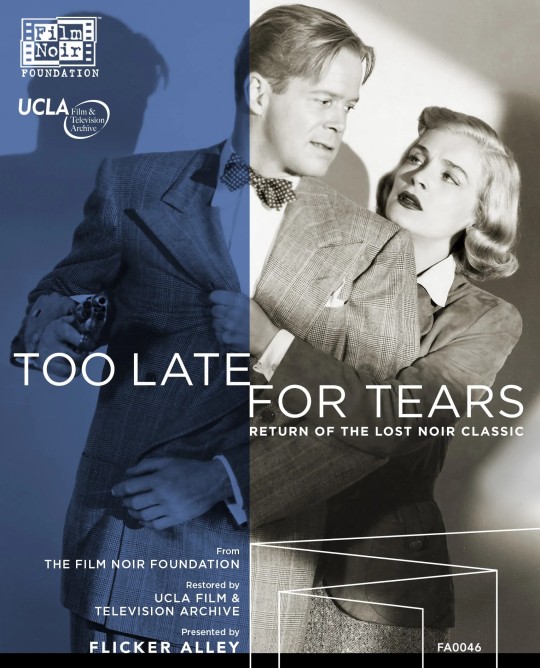

FNF Donation Drive giveaway!
For a chance to win five NOIR CITY Magazine digital back issues — #2, #16, #19, #24, #25 — sent via WeTransfer file transfer service to your email address, donate $20 or more to the FNF between now and May 3. Your name will be entered in a random drawing. Three winners will receive the issues.
And, for a donation of $50 or more, a winner in a random drawing will receive Flicker Alley’s Blu-ray/DVD releases of two FNF restorations — Too Late for Tears (1949) with Lizabeth Scott and Dan Duryea and Trapped with Lloyd Bridges and Barbara Payton. Special features produced by the FNF included on each Blu-ray/DVD.
All winners will be announced Monday, May 6, on the FNF's news page.

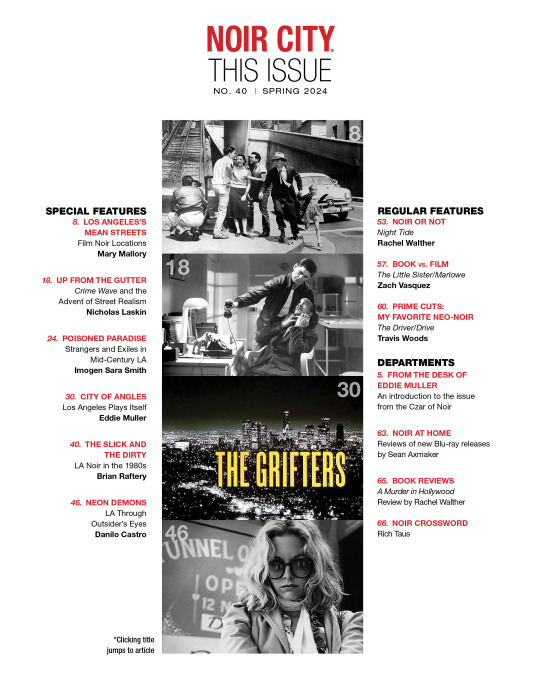
Everyone who donates $20 or more and signs up on our e-mail list, will automatically receive the digital version of NOIR CITY e-magazine for a year! The current issue, our 40th, is concerned exclusively with Los Angeles. We explore the city in the classic noir era and in neo-noir films from the 1960s right up to today. It's a deep dive into cold, dark waters.
Your donations help the FNF locate, restore, and exhibit films that, without our intervention, would be lost forever.
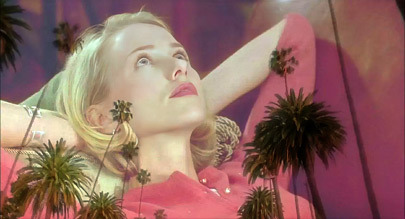
Already a NOIR CITY subscriber? We have drawings for you too!
For $20 donations: three winners in random drawings will receive five NOIR CITY Magazine digital back issues— #2, #16, #19, #24, #25— sent via WeTransfer file transfer service to their email addresses. Two separate $20 donors will receive either the Criterion release DVD of Mulholland Drive (2001) or the FNF restoration Blu-ray/DVD of Too Late for Tears (1949).
For $65 donations: one winner in a random drawing will the Criterion release Blu-ray of Devil in a Blue Dress (1995) starring Denzel Washington, Stranger on the Third Floor (1940) with Peter Lorre, a copy of Eddie Muller’s Gun Crazy: The Origin of American Outlaw Cinema, and illustrator Graham Chaffee’s To Have and To Hold from Fantagraphics.
For $120 donations, continuing the Los Angeles theme, one winner in a random drawing will receive a Blu-ray of Harper (1966) starring Paul Newman; a DVD of The Grifters (1990) with Angelica Huston, John Cusack, and Annette Bening; and the Criterion Blu-ray release of Double Indemnity (1944). We’ll also include an FNF copy (opened) of Cutter’s Way (1981) on a double bill with the non-LA/non-noir Chilly Scenes of Winter (1979) with Gloria Grahame.
For a shot at any of these goods, make your donation to the FNF between now and May 1. Your name will be entered into the random drawings for your donation amount. All winners will be announced on Monday, May 6, on the FNF’s news page.
#film noir foundation#noir city magazine#film restoration#trapped#mulholland drive#eddie muller#too late for tears#los angeles#los angeles noir
12 notes
·
View notes
Text
Interview: Gina Gershon on the Love Story and Legacy of the Wachowskis’ ‘Bound’
Gershon discusses what makes the film such an enduring and endearing queer cinema classic.
by Marshall Shaffer
June 25, 2024

Gina Gershon’s body of work boasts a murderer’s row of formidable directors. Following her debut in John Hughes’s Pretty in Pink, she went on to appear in films by John Sayles, Robert Altman, John Woo, Michael Mann, Olivier Assayas, William Friedkin, and Woody Allen. Yet it’s two fateful collaborations in consecutive years—Paul Verhoeven on 1995’s Showgirls and the Wachowskis on 1996’s Bound—that loom largest over her filmography.
As Corky in Bound, Gershon displays a fierce commitment to the physical and emotional realism of a lesbian ex-con trying to restart her life, seamlessly transmuting the brooding of a classic noir protagonist into the body of a contemporary butch plumber. This makes it all the easier to understand how she’d fall for a traditional femme fatale like Jennifer Tilly’s Violet.
The erotic and ecstatic chemistry between the two escalates into an elaborate heist plot to get out from under Violet’s mafia money-laundering husband, Joe Pantoliano’s Caesar. And at every turn, the Wachowskis match the excitement of their story with equally mesmerizing direction.
In a less forgiving era for female stars as sexual beings on screen, Gershon refused to bow to expectations for how and who her characters could love. Her commitment to the stories she wanted to tell came with costs at the time, but she’s been validated by the long arc of film history. Showgirls and Bound are now remembered as signature cinematic achievements of the 1990s, with the former film a mainstay of often cheeky repertory theater programming and the latter recently receiving a new home video release through the Criterion Collection.
I spoke with Gershon shortly after Bound’s new 4K digital restoration was released by Criterion. Our conversation covered how she developed the character of Corky, where the Wachowskis guided her to see the full picture of Bound’s construction on set, and what makes the film such an enduring and endearing queer cinema classic.
Before we start, I should say that I actually studied Bound in a college film class.
It’s a good one for film class because there’s so much to discuss, just technically, the way it was shot, and the meaning of it. That would be fun. Good for that teacher!
You’ve teased writing a more traditional memoir than your 2012 book In Search of Cleo. How would you tell the story of Bound in your book? What’s the enduring memory that lingers on decades later?
I actually am writing another book, and I talk about Bound. My enduring memory of it always was how shocked I was my agents didn’t want me to do it. Everyone literally was saying, “You’re gonna ruin your career.” It was a moment of like, “What are you talking about?” And I realized how homophobic the business was. I just saw an incredible script and a great opportunity. And they’re like, “Oh, it’s a lesbian movie!” You know, people weren’t doing that then. Which, in retrospect, is just insane. It was a good lesson in just standing up for what you believe. And I was like, “This is my career, I’m doing this. I think the Wachowskis are exceptional filmmakers. I want to play Corky. I think this will be cool.” I’m glad I did.
What guides your instincts in picking films and seeing beyond the immediate concerns of agents and publicists?

You worked with many visionary directors well into their careers. Could you tell the signs were there for the Wachowskis even though it was their first film?
I get this thing in my stomach: If I meet a really good director—or in this case, directors—I just get giddy. I don’t know why or how I know. But if it’s a really talented person, and the Wachowskis are just geniuses with what they did, I know. Certainly, my agents were like [does a nervous voice], “First-time directors…” And I’m like, “Yeah.” The second I started talking to them about certain shots and how they saw the film, I knew they were very special. And I thought, “I’m in.” It’s exciting to be with first-timers where you say, “I believe in these people doing this.” Sometimes I guess you’re wrong, but I wasn’t surprised how well it turned out.
Were you clocking the Wachowskis’ unconventional filming style with so many close-ups and overhead shots? Does that play into your performance?
No, it’s still the same. You’re still trying to be in the moment and truthful. Instead of just wildly going, “I’m just going to do this,” with certain scenes, they’re like, “No, we need you to look to the left because then we’re going to cut it with the Benjamin Franklin dollar bill looking over to the left.” At first, I’m like, “It feels doesn’t feel right looking this way!” And then they would tell me what they were going to cut it to, and I’d be like, “Ahh, super cool! Okay.” Sometimes directors make the mistake of not clueing in their actors, but that only helped me. I’m a visual person. You can tell me a zillion things, and if you show me something, I’m like, “Oh, yeah, cool!” You want to be part of the team and make that cool image happen. It gave you boundaries of how and where you’re going to be looking. Hopefully, if you do your work, it doesn’t matter.
How did the Wachowskis direct you beyond just getting you to hit your marks? How were they helping you find the character?
Oh, that’s interesting, I don’t really remember them ever doing that! [laughs]
Was it just a matter of them trusting you that much?
When I read for Corky, they liked my reading. To me, Corky was very still like those noir guys or actor men who I always projected everything onto. You can’t help but fall in love with [them]. It was a different, and very still, sort of performance for me. You try not to give away too much. Corky is coming out of jail. She doesn’t trust anyone, so she’s clocking everything. In a lot of those scenes, the audience is learning stuff through Corky’s eyes. I think we were just in cahoots with how that was going on. Maybe [they said], “Amp this or that up,” but it was also a while ago, so I don’t recall. It was more of a physical thing: “You’ve got to look this way.”
Your preparation for the film included looking at swaggering icons like Marlon Brando, Montgomery Clift, and Robert Mitchum. How do those inspirations manifest inside Corky? Is it a matter of incorporating masculinity into the character or blurring the gender binary altogether?
I know, as a woman, what I thought was really sexy when I would look at a man. The way he would hold a beer, certain things as a female looking at a male, I’m like, “Oh, that’s so cool. That’s so sexy.” It was just very quintessential male, like the way they would hold a steering wheel. Those are just like my own little quirks that I love!
It was more of an emotional thing. I started boxing to learn stillness. Instead of being like a [Marvin] Hagler, I wanted to be more like a Sugar Ray [Leonard]. He just moved when he needed to. He was very calm, and I think it was that energy I was tapping into more than anything else. That comes out of you [not wanting] to get hit. It’s a trust issue, who are these people? I didn’t look at it as male or female. I just looked at it as an energy of why they are being that way. It was always very alluring to project onto someone who’s doing…not that you’re doing nothing, but Corky was an interesting character to let people project onto.
It also feels like these characters are consciously playing a part based on what they’ve seen in the culture. Listening to the archival commentary track on the Criterion release, I heard that the Wachowskis gave The Treasure of the Sierra Madre to Joe Pantoliano as a direct influence within a scene.
Interesting, I don’t remember them telling me [to go in that direction]. I go interior-exterior. I just think if you’re someone who’s gauging what is going on and clocking the room and reading the room, it’s not out of insecurity. You don’t give anything away. You don’t make yourself vulnerable in a situation. You just have to figure out: Is this safe? That’s where I think her stillness comes from. Listen, I remember falling in love younger, like, “Oh, he’s so tall, dark, handsome, and quiet.” And then later on, you’re like, “Oh, he’s quiet because he has literally nothing to say!” But you don’t know that at first. And I think there’s something alluring about projecting onto someone and making them much more than they are.
There was some back-and-forth between you and Jennifer on who should play which character in the film. Was each of you having that insight into both Violet and Corky something that helped the production?
I never saw Jennifer [playing Corky]. I think I was playing her [from the start], and then we went to go see Jennifer because they obviously had to see our chemistry. We went to visit her—I want to say Las Vegas, but I could be completely making that up. Jennifer is so animated, so girly, and so like [impersonating Tilly], “Alright, well, you know…” It was so fun to watch! I just thought, “Oh my god, I could do this with her.” As a dude trying to get that energy of just watching some girl, I could watch Jennifer forever and be entertained. And I think there was that element of like, “Who is this creature in front of me?” She’s very alluring, and you could see why Corky would fall in love with Violet even against her better judgment.

How do you feel when the tide starts to shift on a film like Showgirls or Bound? When does the initial reception fade into the background and you can tell it’s been reclaimed as something like a cult classic?
That’s interesting, isn’t it? As soon as Bound came out and people started seeing it, everyone was into it. It was just a matter of the NC-17 from the rating boards. As soon as actors, directors, and regular people started watching the movie, it became a classic instantly.
Showgirls has got its own trajectory. I went to a screening the other night of the film at the Paris Theater. A friend of mine was like, “You have to come and see this,” because I always think I just get PTSD when I watch it. I hadn’t seen it in so long, but seeing it now was so interesting. It’s got a totally different meaning, and maybe people unconsciously were tapping into that. But I find it more interesting that the critics, people who absolutely hated this movie [and said] “this is the worst movie”…to this day, everyone asks me about it. What does that tell you? It’s interesting.
Has the meaning or experience of Bound changed at all for you, especially now knowing it was the project of two transgender women who might not have necessarily had the language or the knowledge to express themselves directly?
I remember asking them, “What do you know about being a woman? How are you going to direct this?” Which feels kind of foolish in retrospect! It certainly had a different meaning to them that I wasn’t aware of. But I think, in general, everyone in that movie is in a box. They’re all bound in some way, and everyone’s trying to become free to be able to be who they are. Of course, we could read so much more into it. I’m sure there’s a reason why they wrote it, but I didn’t know that at the time. I think it’s pretty cool! [laughs]
When you think about the imagery of the closet or even something like the thin walls between the apartments, those feel ripe for symbolic analysis. As you mentioned at the start, it’s a rich text in that way.
I mean, the pipes are all throughout the movie. There’s water, sweat, and wetness. It’s very, very clever. It’s a good thing to have in film school, right? There are a zillion essays [to write] on it.
Have you been involved or consulted on the upcoming stage adaptation of Bound?
I heard about that, but I wasn’t really that aware of it. I mean, it’d be fun to see! Listen, I always felt we were basically doing it in one or maybe two rooms, and I used to say, “God, this could literally be done as a play!” The writing is good enough, although I think so much of the fun of this is the way it looks, the way it’s shot, and the nods to film noir but turning it on its head.
Do you think a version of Corky in 2024 would be played similarly to the way that you played it?
Hopefully, every actress is going to play something differently, but I think the ultimate essence is still the same. To me, it was always a love story. It was about trust. How do you trust someone to give yourself over to them? For me, as Corky, that was the bigger [story]. I never really looked at it like, “Oh, it’s a lesbian, it’s a guy, it’s a girl…” I just thought, “Will I trust this person enough to go all the way in and risk my life?” I’ll be very curious to see what they do with the adaptation. I bet it’ll be cool. I hope it’s cool!
7 notes
·
View notes
Text
"The Man of a Thousand Face"

Also known as Lon Chaney Sr., an icon of classic films and if you are a fan of the Phantom of the Opera you will recognize him for made the first film version of Erik hehe
#lon chaney#lon chaney sr#old cinema#old hollywood#old films#classic film stars#classic film#silent era#silent film#silent cinema#film noir#silent horror#vintage hollywood#vintage movies#vintage#artists on tumblr#artwork#traditional drawing#pencil drawing#tumblr draw#digital drawing#retrato#rigelkentauruus#the man of a thousand faces
4 notes
·
View notes
Text
On the concept of "elevated horror"...
The whole concept of "elevated horror" as a recent trend is not only flatly incorrect, but also insulting to everyone involved. First of all, people have been making arthouse, non-stereotypical, and/or high quality horror since pretty much the dawn of film, but you rarely see those films mentioned as "elevated horror." Like... Silence of the Lambs? The Exorcist? Rosemary's Baby? The Cabinet of Dr. Caligari? Vampyr? All really well-made and groundbreaking horror films that had something new to say. The idea of making high quality horror with actual themes was not invented by A24.
Second of all, I don't like how this term differentiates films based on quality. No other genre is so disrespected that people feel a need to separate out the best made films into a subgenre. Do you hear people say "This is historical fiction, but it's good historical fiction!" or "This sci fi film elevates itself above regular science fiction!" No. Because people don't automatically assume those genres are trash.There's no subgenre of "good horror" as opposed to "regular horror." There's good and bad horror movies just like in any other genre.
Lastly, I think you do a disservice to trashy movies by assuming they have no skill or themes or messaging involved. One of the first films people throw under the bus is Friday the 13th, but that was a successful franchise for a reason — the first movie is undeniably pretty good, subverts audience expectations, and also provides insight into cultural attitudes of the era. And because it's a long-running series, you can watch those cultural attitudes evolve over time just by watching Friday the 13th sequels. There's a lot of value to that.
There's a lot of value to "trash cinema" in general. A movie that doesn't have quality standards is a movie that isn't bowing to societal norms or acceptance. Those $10 budget, horrid SFX, cringe-acted horror films exist in a forbidden space where critical reviews and mainstream audience approval aren't there to censor them. That is incredibly cool. Every stupid little terrible horror movie we have that survived decades and got digitized is a gift to the culture. We deserve to know what film enthusiasts were doing when they weren't the kind of people who could get massive studio budgets. Notably, you also see a lot more queer people, women, and POC in those spaces too. Horror makes space for the people who have been spat out by the mainstream.
And that's kind of the root of horror films, I think. They dig up the forbidden and put it on screen. So if you think the only horror films with any value are the ones that mainstream critics approve of, that aren't doing anything to upset the status quo, then you're missing the entire point.
12 notes
·
View notes